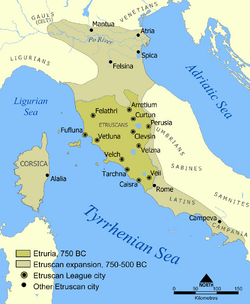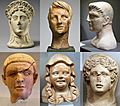Etruscan origins facts for kids
There are three main hypotheses as to the origins of the Etruscan civilization. Autochthonous development in situ out of the Villanovan culture, as claimed by the Greek historian Dionysius of Halicarnassus who described the Etruscans as indigenous people who had always lived in Etruria. A migration from the Aegean sea, as claimed by a couple of Greek historians: Herodotus, who described them as a group of immigrants from Lydia in Anatolia, and Hellanicus of Lesbos who claimed that the Tyrrhenians were the Pelasgians originally from Thessaly, Greece The third hypotheses is reported by Livy and Pliny the Elder, the Etruscans as related to Rhaetian people to the north and other populations living in the Alps.
German linguist Helmut Rix proposed the Tyrsenian language family, with Etruscan related to the Rhaetic language spoken in the Alps north of Etruria, and to the Lemnian language spoken in Lemons. In particular the Lemnian language could have arrived in the Aegean Sea during the Late Bronze Age, when Mycenaean rulers recruited groups of mercenaries from Sicily, Sardinia and various parts of the Italian peninsula.
The latest mtDNA study (2013) suggests that the Etruscans appear to fall very close to a Neolithic population from Central Europe and to other Tuscan populations.
Images for kids
-
The Mars of Todi, a life-sized bronze sculpture of a soldier making a votive offering, late 5th to early 4th century BC








